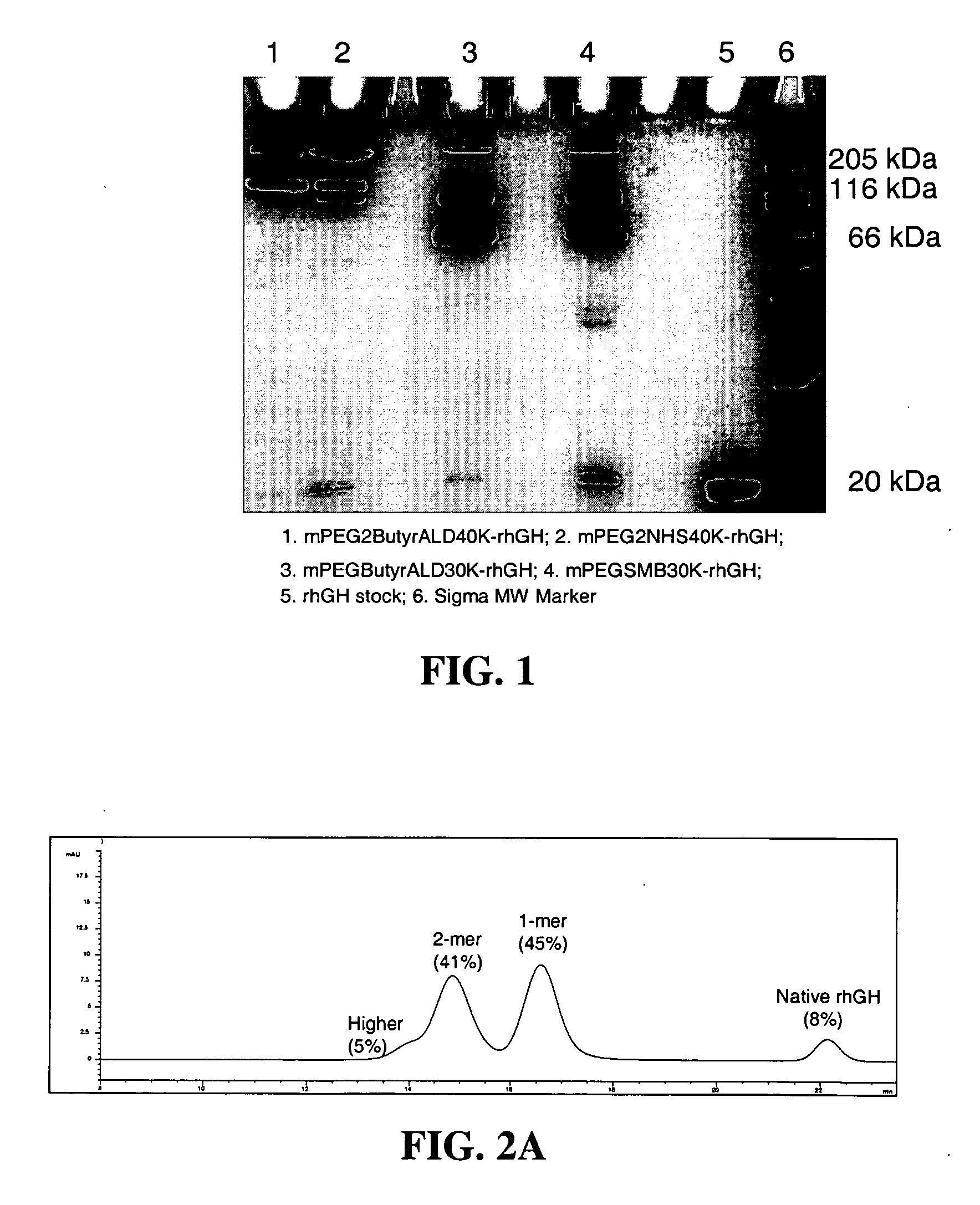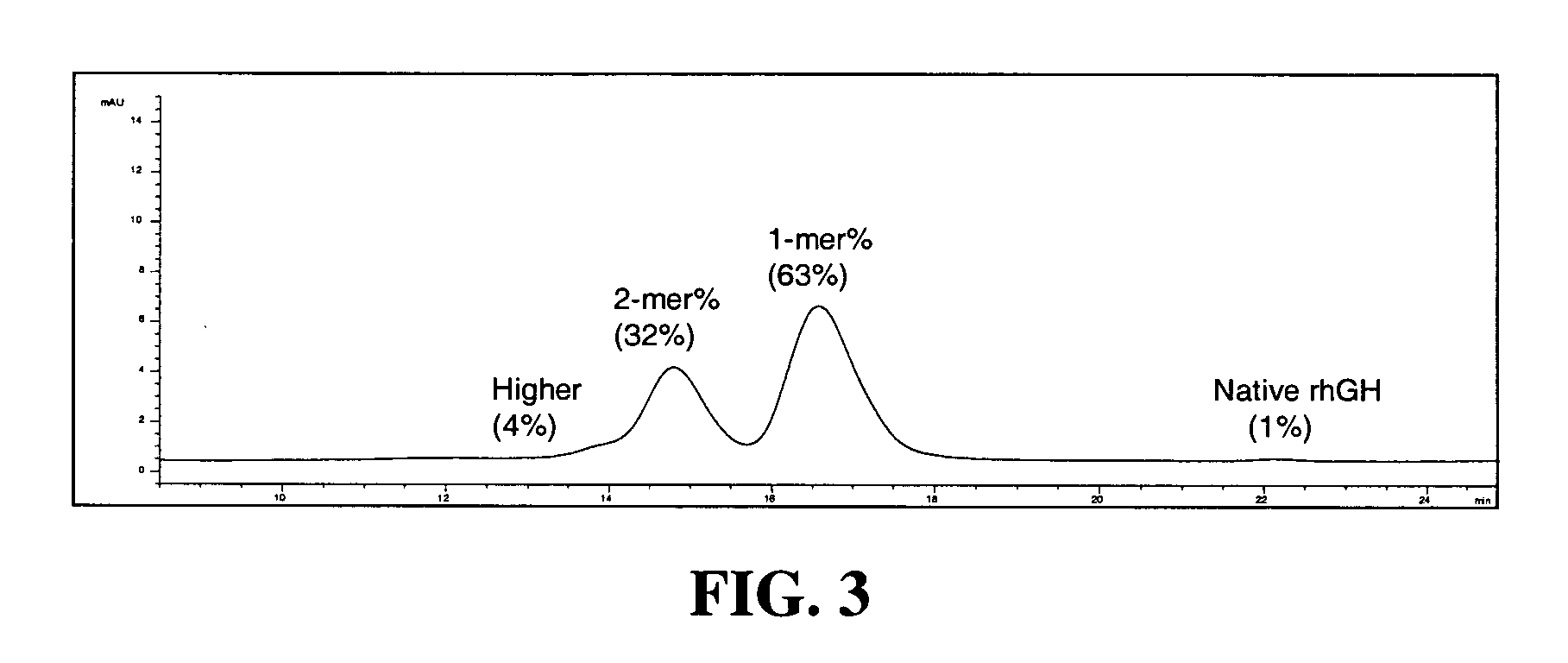Conjugates formed from polymer derivatives having particular atom arrangements
a technology of derivatives and conjugates, applied in the direction of heterocyclic compound active ingredients, peptides/protein ingredients, peptides, etc., can solve the problems of inconvenient and painful, short half-life, and difficult delivery of active agents such as polypeptides
- Summary
- Abstract
- Description
- Claims
- Application Information
AI Technical Summary
Benefits of technology
Problems solved by technology
Method used
Image
Examples
example 1
Preparation of a Glycerol-Based Precursor Molecule
[0250]
[0251] A solution of cis-1,3-O-Benzylideneglycerol (7.2g, 0.040 moles) (Sigma-Aldrich Corporation, St. Louis, Mo.) in toluene (100 ml) was azetropically dried by distilling off toluene. The dried compound was dissolved in anhydrous toluene (100 ml) and 1.0M solution of potassium tert-butoxide in tert-butanol (60 ml, 0.060moles) and 1-(3-bromopropyl)-4-methyl-2,6,7-trioxabicyclo[2,2,2]octane (14.0g, 0.0558 moles) were added and the mixture was stirred overnight at 100° C. under argon atmosphere. The mixture was filtered and the solvent was distilled off under reduced pressure giving 15.7 g of solid product (Compound 5-02). NMR (d6-DMSO): 0.74 ppm (s, 3H), 1.61 ppm (m, 4H), 1.88 ppm (m, 2H), 3.44 ppm (t, 2H), 3.81 ppm(s, 6H), 4.05 ppm (m, 4H), 5.55 ppm (s, 1H), 7.37 ppm (m, 5H).
[0252] Schematically, the reaction is represented as follows:
[0253] Hydrolysis of 5-02. Compound 5-02 (15.0 g) was dissolved in a mixture of acetonitr...
example 2
Preparation of “mPEG2(40K)-Butanoic Acid, N-Hydroxysuccinimide Ester” or “mPEG-2-NHS”
[0262]
(wherein mPEG20K designates a PEG having a molecular weight of 20,000 Daltons) “mPEG2(40K)-Butanoic Acid, N-Hydroxysuccinimide Ester”
[0263] Activation of the hydroxyl groups in the precursor molecule. Compound 8-02 (2.0 g, 0.0208 equivalents) was dissolved in anhydrous acetonitrile (50 ml) and anhydrous pyridine (2.2 ml, 0.272 mole) and N,N-disuccinimidyl carbonate (5.86 g, 0.0229 mole, DSC) were added. The solution was stirred overnight at room temperature under argon atmosphere. Next, the mixture was filtered and the solvent was distilled off. The crude product was dissolved in CH2Cl2 (50 ml) and washed with a 5% H3PO4 solution. The solution was then dried (MgSO4), and the solvent was distilled off. The resulting product (Compound 9-02) had a yield of 2.8 g. NMR (d6-DMSO): 1.76 ppm (m, 2H), 2.35 ppm (t, 2H), 2.82 ppm (s, 8H), 3.56 ppm (t, 2H), 3.58 ppm (s, 3H), 3.96 ppm (m, 1H), 4.37 ppm (m...
example 3
Preparation of a “mPEG2(40K)-Butyraldehyde” or “mPEG2-ButyrALD”
Preparation of Tetra(ethylene glycol) mono-butyraldehyde, diethyl acetal
HO—(CH2CH2O)4CH2(CH2)2—CH(OCH2CH2)2
[0272] A mixture of tetra(ethylene glycol) (97.1 g, 0.500 moles) and toluene (200 ml) was azeotropically dried by distilling off toluene under reduced pressure (rotary evaporator). The dried tetra(ethylene glycol) was dissolved in anhydrous toluene (180 ml) and 1.0 M solution of potassium tert-butoxide in tert-butanol (120.0 ml, 0.120 moles) and 4-chlorobutyraldehyde diethyl acetal (18.1 g, 0.100 moles) (Alfa Aesar, Ward Hill, Mass.) were added. The mixture was stirred at 95-100° C. overnight under argon atmosphere. After cooling to room temperature, the mixture was filtered and the solvents were distilled off under reduced pressure. The crude product was dissolved in 1000 ml deionized water and the resulting solution was filtered through active carbon. Sodium chloride (10 g) was added and the product was extracte...
PUM
| Property | Measurement | Unit |
|---|---|---|
| Mass | aaaaa | aaaaa |
| Mass | aaaaa | aaaaa |
| Mass | aaaaa | aaaaa |
Abstract
Description
Claims
Application Information
 Login to View More
Login to View More - R&D
- Intellectual Property
- Life Sciences
- Materials
- Tech Scout
- Unparalleled Data Quality
- Higher Quality Content
- 60% Fewer Hallucinations
Browse by: Latest US Patents, China's latest patents, Technical Efficacy Thesaurus, Application Domain, Technology Topic, Popular Technical Reports.
© 2025 PatSnap. All rights reserved.Legal|Privacy policy|Modern Slavery Act Transparency Statement|Sitemap|About US| Contact US: help@patsnap.com



